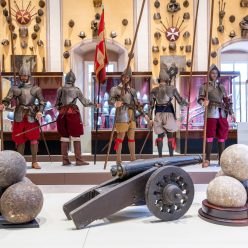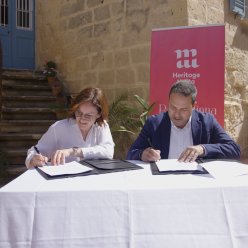14/12/2021
An exhibition focusing on the archaeology of Medieval Gozo has just been launched at the Romegas Hall of the National Museum of Archaeology in Valletta. It will run until February 2022.
‘An Island in Transition – 700 to 1700AD: The Archaeology of Medieval Gozo’ provides an overview of Gozo’s medieval heritage as seen from an archaeological perspective. It is the second event in the Medieval Malta exhibition series, an initiative of Heritage Malta and of the National Museum of Archaeology aimed at promoting greater public appreciation of Malta’s medieval heritage. The first exhibition was dedicated to the archaeology of Malta’s Dark Ages (9th to 10th century AD).

Speaking at the exhibition’s inauguration, José Herrera, Minister for the National Heritage, the Arts and Local Government, said that although this exhibition focuses on Medieval times, the four case studies that are being presented – each dealing with a different aspect of medieval culture – are still very relevant today. These are Maritime Trade, Art, the Rural Landscape and Artisanal Production. In particular, the exhibition focuses on a central question: Was medieval Gozo peripheral or was it a well-connected island?
Kenneth Gambin, Heritage Malta’s Chief Operations Officer, spoke of how this exhibition is the result of a close collaboration between Heritage Malta’s National Museum of Archaeology and the Gozo Museum of Archaeology. The exhibition has also benefitted greatly from the additional collaboration of the Superintendence of Cultural Heritage and the Sannat Local Council. Along with the exhibition of Giorgio Preca’s paintings at MUŻA, this exhibition enhances the visitor experience at Valletta’s museums and sites, particularly during the Christmas period. Heritage Malta plans to set up the exhibition in Gozo as well next year.
Nathaniel Cutajar, Principal Curator at the National Museum of Archaeology, said that Gozo’s medieval millennium is in many ways uncharted territory. No secure information exists on Gozo before the mid-13th century. After that date historical information starts becoming sporadically more available, but only for limited aspects of social life. Gozo irretrievably lost most of its medieval archives and artistic heritage following the dramatic invasion of 1551 – it was as if a millennium had been erased from the historical record. Archaeology therefore plays an important role in filling out some of these historical gaps.
Entrance to the exhibition is free of charge. A booklet is available for sale.
Latest News






